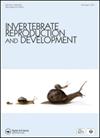The trade-off between adult size and development time due to different feeding regimes in the scorpion Tityus neibae
IF 0.8
4区 生物学
Q4 REPRODUCTIVE BIOLOGY
引用次数: 2
Abstract
ABSTRACT Scorpions often experience food shortages, yet information on their baseline nutritional input is lacking. In many life histories, there is a trade-off between adult size and development time that is interrelated with food availability. We present precise data on the influence of two different feeding regimes that affect development in the buthid scorpion Tityus neibae. The results indicate a strong relationship between the treatment group, sex, morphometrics and life stages. The different diet inputs had no influence on the embryonic development or the litter size but had a major effect on the postembryonic development time and on the life stage when individuals reached maturity. No females or males reached maturity by the 4th instar when fed every two weeks and only males that were fed weekly were able to reach maturity by the 4th. Thus, a trade-off in T. neibae males is apparent, since they can reach maturity earlier in life, resulting in an overall smaller body size that may reduce the risk of predation. By contrast, females may have been selected to reach full development with an overall larger body size that results in an increase in the fitness, the number, or the size of the offspring.天蝎不同摄食方式对成虫体型和发育时间的影响
摘要蝎子经常经历食物短缺,但缺乏关于其基线营养投入的信息。在许多生命史中,成年人的体型和发育时间之间存在着权衡,这与食物的可获得性有关。我们提供了关于两种不同喂养方式对斑蝎Tityus neibae发育的影响的精确数据。研究结果表明,治疗组、性别、形态计量学和生命阶段之间存在着密切的关系。不同的饮食输入对胚胎发育或产仔数没有影响,但对胚胎后发育时间和个体成熟时的生命阶段有主要影响。每两周喂食一次,在4龄时没有雌性或雄性达到成熟,只有每周喂食的雄性能够在4龄达到成熟。因此,奈贝氏锥虫雄性的权衡是显而易见的,因为它们可以在生命中更早地成熟,从而使体型总体更小,从而降低被捕食的风险。相比之下,雌性可能已经被选择以达到完全发育,整体体型更大,这会导致后代的健康度、数量或体型增加。
本文章由计算机程序翻译,如有差异,请以英文原文为准。
求助全文
约1分钟内获得全文
求助全文
来源期刊
CiteScore
1.90
自引率
0.00%
发文量
21
审稿时长
>12 weeks
期刊介绍:
Invertebrate Reproduction & Development ( IRD) presents original research on the reproductive and developmental biology of the Invertebrata, both embryonic and postembryonic. IRD welcomes papers reporting significant results obtained using new techniques. Encouraged topic areas include: aquaculture, physiology, biochemistry, functional morphology, phylogeny, behavioural and regulatory mechanisms, including genetic, endocrine and molecular studies. Papers containing qualitative descriptions of reproductive cycles and gametogenesis will not be considered. IRD is published in association with the International Society of Invertebrate Reproduction and Development.

 求助内容:
求助内容: 应助结果提醒方式:
应助结果提醒方式:


